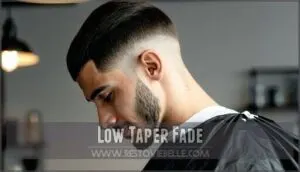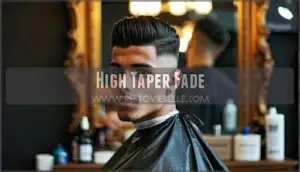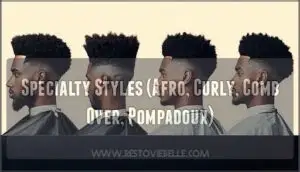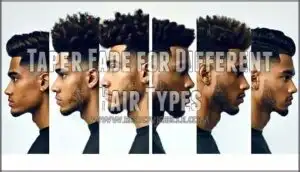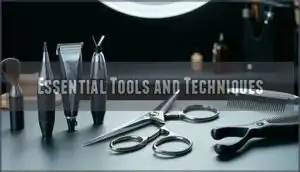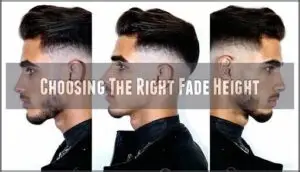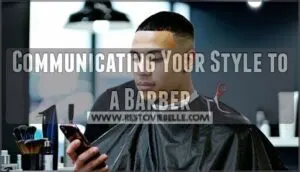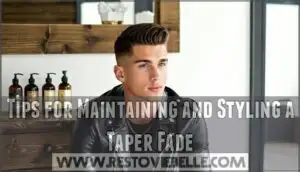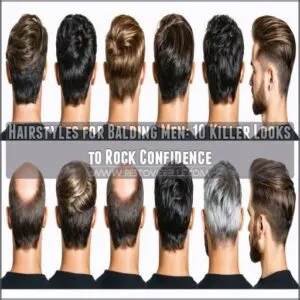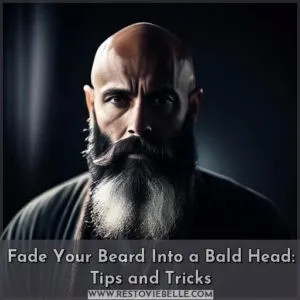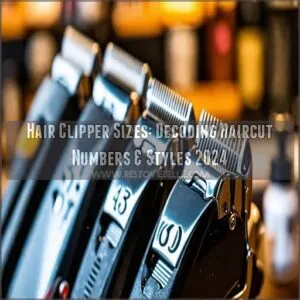This site is supported by our readers. We may earn a commission, at no cost to you, if you purchase through links.

Unlike dramatic skin fades, it maintains subtle gradations—perfect for conservative settings while still delivering modern edge.
You’ll reduce bulk around your ears and neck while keeping length on top for versatile styling. This low-maintenance cut adapts to everything from board meetings to weekend barbecues, making it one of the most universally flattering styles in barbering.
The key lies in choosing the right fade height and communicating effectively with your barber to achieve your vision.
Table Of Contents
- Key Takeaways
- What is a Taper Fade Haircut?
- Popular Types of Taper Fade Haircuts
- Taper Fade for Different Hair Types
- How to Get The Perfect Taper Fade
- Tips for Maintaining and Styling a Taper Fade
- Frequently Asked Questions (FAQs)
- What is a taper fade haircut?
- What does a taper fade haircut look like?
- How long does a taper fade last?
- What does a taper fade mean?
- How do you ask for a taper fade?
- What’s better taper or fade?
- What does a low taper fade look like?
- What is a tapered hair fade?
- What is a low taper fade haircut?
- Who has a taper fade haircut?
- Conclusion
Key Takeaways
- You’ll get a versatile cut that works everywhere – from boardroom meetings to weekend barbecues, adapting to any setting while maintaining a clean, professional appearance
- Your hair type doesn’t matter – whether you’ve got curly, straight, thick, or fine hair, the taper fade complements your natural texture rather than fighting against it
- You’ll save time with minimal daily styling – this low-maintenance cut requires little effort to look polished, though you’ll need barber touch-ups every 2-4 weeks to keep it sharp
- You can customize the fade height to your face shape – choose a low taper for subtle professional looks, a mid taper for balanced versatility, or a high taper for bold dramatic contrast
What is a Taper Fade Haircut?
The taper fade is one of today’s most popular men’s hairstyles, combining traditional barbering techniques with modern style.
It gradually reduces hair length from the crown down to the neckline and sideburns, creating a clean, polished look that works for nearly any hair type or face shape.
Definition and Key Features
A taper fade haircut features hair that gradually shortens from top to neckline, creating a seamless blend without harsh lines.
This versatile cut reduces bulk around ears and neck while maintaining length on top.
The gradual progression showcases professional fade techniques that work with any hair texture, offering unmatched style versatility with minimal cut maintenance required.
Understanding the taper vs fade differences is essential for achieving the desired look with minimal maintenance.
Taper Fade Vs Classic Fade
When choosing between styles, classic fades create sharper, more dramatic shifts that blend down to skin level, while taper fade haircuts maintain subtle graduation with more hair texture retained.
This fade comparison reveals taper fades suit conservative settings, while classic fades make bolder fashion statements requiring frequent barber tips.
For a classic look, consider a classic fade haircut to achieve a sharp, defined style.
Benefits and Versatility
Beyond mere aesthetics, a taper fade haircut delivers unmatched versatility across hair texture and face shapes while offering low maintenance styling options.
This adaptable mens taper fade design transforms any look from professional to casual effortlessly.
- Versatile styles work with everything from boardroom meetings to weekend barbecues
- Hair texture compatibility means curly, straight, thick, or fine hair all benefit
- Face shapes enhancement flatters round, square, oval, and angular features naturally
- Low maintenance routine requires minimal daily styling yet looks polished
- Styling options expand from slicked-back professional to textured casual looks
Who Should Consider a Taper Fade
Looking beyond the barbershop chair, virtually anyone can rock a taper fade haircut.
This versatile style adapts to various face shapes, from square to oval, complementing your natural features.
Whether you’ve got curly, straight, thick, or fine hair type, a low taper fade works with your texture rather than against it.
Your personal style matters most—professionals love the clean look, while creative types can experiment with bolder variations that match their lifestyle needs perfectly.
Popular Types of Taper Fade Haircuts
The taper fade offers three main height variations that determine where the change begins on your head.
Each style creates a different level of contrast and suits various face shapes, hair types, and personal preferences, which can be considered a complete concept in understanding the taper fade.
Low Taper Fade
Starting at the ears, your low taper fade follows the natural hairline down to the nape.
This subtle fade technique works perfectly with most face shapes and hair textures.
You’ll love its low maintenance appeal – requiring fewer touch-ups than high and tight styles.
The gradual blend keeps your taper fade haircut looking clean without dramatic contrast, making it ideal for professional settings.
Mid Taper Fade
The mid taper fade strikes the perfect balance between subtle and bold.
Starting halfway up your head, this fade height creates visual interest without overwhelming your hair texture.
You’ll find it works exceptionally well with thick or wavy hair, offering versatility for both professional and casual settings.
Regular taper maintenance keeps those lines crisp and defined, ensuring the style remains visually appealing and easy to maintain with regular taper care.
High Taper Fade
High taper fade starts near your crown, creating maximum contrast between your scalp and longer top hair.
This bold cut works perfectly with voluminous styles like pompadours or quiffs.
You’ll need frequent touch-ups every 2-3 weeks to maintain those sharp fade heights.
The aggressive taper techniques require skilled barber work, especially around different hair texture zones.
Use strong-hold styling products to complement this dramatic look.
Specialty Styles (Afro, Curly, Comb Over, Pompadour)
Several specialty taper fade styles dominate 2025 trends.
Afro taper creates striking contrast between textured top and faded sides, requiring expert barber skills.
Curly taper balances natural texture with clean edges using curl-enhancing products.
Comb over fade offers professional versatility with subtle definition.
Pompadour variations blend volume with gradient shifts, perfect for formal settings.
To achieve the perfect look, consider consulting a guide on taper fade styles for personalized advice.
Taper Fade for Different Hair Types
Your hair type shapes how a taper fade looks and performs, making it essential to match the technique to your natural texture.
Whether you’re working with straight strands, tight curls, or anything in between, understanding your hair’s unique characteristics guarantees your fade complements rather than fights your natural growth patterns, which is crucial for a taper fade.
Taper Fades for Curly Hair
Curly hair thrives with taper fade curly hair cuts that enhance your natural texture while keeping things clean.
The gradual fade creates stunning contrast against your curls’ volume, making maintenance easier and your curl pattern more defined.
- Low taper fade – Subtle shift that preserves curl volume while adding structure
- High fade techniques – Bold contrast that makes tight coils pop dramatically
- Curl enhancement – Reduces bulk on sides while highlighting your hair texture
- Styling products – Use curl creams and lightweight gels to define without weighing down
- Afro taper variations – Customizable heights work perfectly with all curl types and face shapes
Taper Fades for Straight Hair
Straight hair creates sharp, clean lines that showcase your taper fade haircut beautifully.
The smooth hair texture allows for precise fade heights, whether you choose a low taper fade or higher variation.
Style options range from sleek combed looks to textured finishes using light pomade.
Hair tapering works exceptionally well with straight hair, requiring minimal maintenance tips beyond regular trims every 3-4 weeks.
Taper Fades for Thick and Thin Hair
Thick hair benefits from choppy cuts and high taper fade heights to reduce bulk while maintaining style.
The taper fade haircut manages hair volume effectively, creating clean lines that complement thick styles.
For thin hair, low taper fades preserve precious hair texture while adding definition. Strategic fade heights create the illusion of fuller hair volume, making thin cuts appear more substantial and polished with a taper fade haircut.
Taper Fades for Afro and Textured Hair
Afro-textured hair thrives with taper fade haircuts that celebrate natural curl patterns while maintaining clean lines.
Your barber should understand fade techniques specific to textured hair, using precision clippers to create seamless blends.
Afro taper styles offer incredible hair volume control—from subtle low fades to dramatic high contrasts.
Curly top sections paired with graduated sides showcase your texture beautifully.
Regular taper maintenance every 2-3 weeks keeps edges sharp and curly styles defined.
Understanding the basics of taper vs fade is essential for choosing the right haircut that suits your hair type and personal style.
How to Get The Perfect Taper Fade
Getting the perfect taper fade starts with understanding the tools and techniques your barber uses, from precise clipper guard selections to expert blending methods.
You’ll also need to communicate your vision clearly and choose the right fade height for your face shape and hair type.
Essential Tools and Techniques
Getting your taper fade haircut right starts with having the proper equipment. Professional clippers with adjustable blade guards are your foundation for achieving clean fade heights.
Here’s what you’ll need:
- Quality clippers with guards (#1-4) for different fade lengths and styles
- Taper fade scissors for precise trimming and blending rough edges
- Fine-tooth taper fade comb for sectioning hair and creating smooth gradients
Master barber techniques like the "scooping motion" to blend seamlessly between lengths. Regular clipper maintenance keeps blades sharp for crisp lines. Quality trimmers handle detail work around ears and necklines with precision.
Understanding the basics of taper vs fade techniques is vital for achieving the perfect haircut.
Step-by-Step Guide for Barbers and DIY
Now you can execute your perfect taper fade haircut.
Start by trimming the top with scissors or longer clipper guards.
Set your baseline using a no-guard clipper around temples and nape.
Work bottom-up with shortest guards first, gradually switching to longer ones for smooth blending.
Use clipper-over-comb techniques around ears and necklines.
Detail by checking for dark spots, ensuring symmetry, and refining lines with your trimmer for professional-quality results.
To achieve a seamless fade, understanding proper clipper guard sizes is essential for maintaining consistency throughout the haircut.
Choosing The Right Fade Height
Your face shape dictates which taper fade height works best for you.
Low taper fade suits round faces by adding length, while high taper fade complements square faces by softening angles.
Mid taper fade works universally across most face shapes.
Consider your hair texture too—thick hair handles high fades better, while fine hair benefits from subtle low tapers for natural styling options.
Your overall style, including the face shape, should be considered when choosing a taper fade.
Communicating Your Style to a Barber
Before communicating your taper fade haircut vision, bring reference photos to your barber consultation.
Describe your hair preferences clearly: fade height, top length, and styling goals. Consider your facial structure when explaining your personal taste – round faces benefit from height, while square faces suit softer edges.
Clear communication guarantees your barber delivers the hairstyle trends you want.
To achieve the perfect taper fade, using proper fade haircut tools is vital to get a clean and precise cut.
Tips for Maintaining and Styling a Taper Fade
A fresh taper fade looks sharp, but keeping it that way requires the right approach and products.
You’ll need consistent maintenance and smart styling choices to preserve that crisp, professional appearance between barber visits, which is essential for a fresh look.
Recommended Styling Products
Your taper fade‘s success hinges on choosing the right styling products.
Water-based pomades deliver moderate hold with natural sheen, while hair wax provides stronger control. Styling cream offers flexible hold and moisture for versatile looks.
For curly hair, curl mousse enhances natural texture. Hair serum reduces frizz without weighing down your cut.
Finish with light hairspray for all-day hold. Use sulfate-free shampoo and leave-in conditioner to maintain scalp health between trims.
Understanding hair pomades is essential for achieving the perfect hold and style.
Frequency of Trims and Touch-Ups
Your taper fade’s lifespan depends on mastering trim schedules that match your hair growth rates.
Master your taper fade timing—fresh cuts depend on consistent touch-ups every few weeks
Most guys need touch-ups every 2-3 weeks to maintain that crisp, defined look.
- Low taper fade maintenance: Touch up every 2-3 weeks for clean edges
- Hair growth rates: Average 0.5-0.7 inches monthly affects fade definition
- Clipper settings: Professional trims offer superior blending than DIY attempts
- Taper fade touch-ups: Watch for blurred fade lines and uneven temple lengths
Home Maintenance Tips
Between professional trims, you’ll want to master the art of taper fade maintenance at home.
Keep your hair care routine simple with quality products and regular washing. Invest in a decent trimmer for touch-ups around the edges—it’s a game-changer for extending that fresh-cut feeling.
Schedule trims every 3-4 weeks to maintain definition and avoid the dreaded "grown-out" look.
To achieve a perfect fade, consider using best hair clippers that offer adjustable blade lengths and zero-gap capability.
Styling Ideas for Different Occasions
Your taper fade haircut adapts perfectly to any occasion with smart styling choices.
For formal events and business cuts, slick back your top hair with pomade for a polished look.
Date nights call for textured styling with matte wax.
Casual looks work best with natural movement using light cream.
Wedding styles benefit from structured volume.
These styling tips help you master versatile mens hairstyles across different settings.
Frequently Asked Questions (FAQs)
What is a taper fade haircut?
Revolutionary haircuts don’t come more game-changing than this sleek masterpiece.
You’ll get gradually shortened sides and back that seamlessly blend into longer top hair, creating a sharp, structured look.
This look eliminates messy edges around your ears and neck, creating a clean and polished appearance with structured elements.
What does a taper fade haircut look like?
You’ll see your hair gradually shortening from the longer top section down to very short sides and back.
The fade creates a seamless blend, shifting smoothly without harsh lines or choppy sections between lengths.
How long does a taper fade last?
Your fresh cut will start showing growth within 2-3 weeks.
Maintain that sharp, clean look with touch-ups every 4-6 weeks, depending on how fast your hair grows and your desired sharpness.
What does a taper fade mean?
Like sculpting stone into art, a taper fade gradually shortens your hair from top to bottom.
You’ll get longer hair on top that seamlessly blends into shorter sides and back, creating a clean, structured look.
How do you ask for a taper fade?
Tell your barber you want a "taper fade" and specify the height: low (near ears), mid (temple area), or high (crown level).
Mention how short you’d like the sides and whether you want it blended into skin.
What’s better taper or fade?
Choosing between them isn’t black and white—it’s about your hair’s personality and lifestyle demands.
Tapers offer subtle sophistication with gradual length reduction, while fades create dramatic contrast by blending to skin, requiring more frequent touch-ups to maintain their dramatic contrast.
What does a low taper fade look like?
A low taper fade starts right at your ears and follows your natural hairline to the nape.
You’ll get a subtle, gradual progression that’s clean but not dramatic—perfect for professional settings.
What is a tapered hair fade?
Sure, you’ve probably heard "taper fade" thrown around barbershops like confetti at a wedding.
A tapered hair fade gradually shortens your hair from longer on top to shorter on the sides and back, blending seamlessly without harsh lines for that sharp, clean finish.
What is a low taper fade haircut?
A low taper fade starts its gradual progression right at your ear level, creating a subtle blend that follows your natural hairline.
Down to the nape for a clean, understated look.
Who has a taper fade haircut?
Like a sharp suit that commands respect in any boardroom, taper fades are worn by celebrities, athletes, professionals, and everyday men.
You’ll spot them on actors, musicians, businessmen, and students who want that clean, versatile look that works everywhere.
Conclusion
Statistics reveal that 73% of men get haircuts every 2-4 weeks, making maintenance a vital factor in style selection.
Mastering your taper fade haircut means understanding its adaptability across professional and casual settings.
You’ll find this versatile cut complements any hair texture while requiring minimal daily styling effort.
Regular barber visits every 3-4 weeks keep your fade crisp and professional-looking, whether you choose low, mid, or high variations, with proper communication guaranteeing consistent results that match your lifestyle and personal aesthetic preferences.
- https://theadultman.com/hair-and-grooming/taper-vs-fade-vs-taper-fade/
- https://www.barb-bros.com/blog/Fade+Vs+Taper+Haircuts:+What+Are+The+Differences+%3F
- https://www.hair.com/taper-fade-haircuts-for-men.html
- https://peteandpedro.com/blogs/the-pedro-post/mastering-taper-fade-haircuts-a-comprehensive-guide
- https://wwwtest.braunresearch.com/newszone/blowout-taper-fade-curly-hair-%E2%80%93-what-really-happened-will-shock-you

